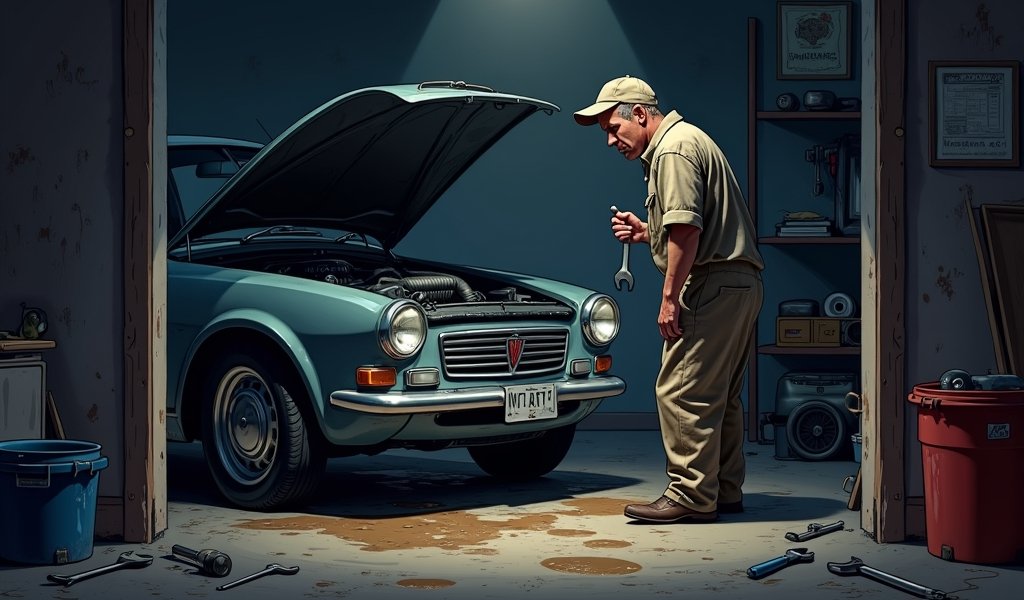Overview
This article details five essential DIY car maintenance procedures—oil changes, brake pad replacement, air filter replacement, spark plug replacement, and battery maintenance—that save money while extending vehicle life. By mastering these tasks with proper tools and safety precautions, car owners can develop mechanical skills and build confidence while ensuring their vehicles perform optimally for years to come.
Table of Contents
- The Power of DIY Car Maintenance: Taking Control of Your Vehicle’s Health
- Why DIY Car Maintenance Matters: Saving Money and Extending Vehicle Life
- Fix #1: Mastering the Oil Change – The Lifeblood of Your Engine
- Fix #2: Brake Pad Replacement – Ensuring Safety and Performance
- Fix #3: Air Filter Replacement – Helping Your Engine Breathe
- Fix #4: Spark Plug Replacement – Restoring Power and Efficiency
- Fix #5: Battery Maintenance and Replacement – Ensuring Reliable Starts
- Essential Tools for DIY Car Maintenance Success
- Safety First: Precautions for DIY Car Maintenance
- Conclusion: Empowering Yourself Through DIY Car Maintenance
- Frequently Asked Questions
The Power of DIY Car Maintenance: Taking Control of Your Vehicle’s Health
There’s something deeply satisfying about getting your hands a little dirty and keeping your vehicle running smoothly through diy car maintenance. As someone who’s spent over two decades under the hood, I can tell you that maintaining your own car isn’t just about saving money—though that’s certainly a nice bonus. It’s about developing a relationship with your vehicle, understanding its quirks and needs, and taking pride in its performance.
The beauty of diy car maintenance lies in its accessibility. You don’t need to be a certified mechanic to perform many essential tasks that keep your car in peak condition. With the right guidance, tools, and a bit of patience, you can tackle numerous maintenance jobs that will extend your vehicle’s life and enhance its performance. And trust me, there’s nothing quite like the feeling of driving a car you’ve personally maintained—it’s like hearing your favorite song on a speaker system you tuned yourself.
In this guide, I’ll walk you through five proven diy car maintenance fixes that deliver the biggest bang for your buck in terms of vehicle performance and longevity. These aren’t just random fixes—they’re the foundation of a well-maintained vehicle, the bread and butter of what we professionals focus on first. By mastering these fundamentals, you’ll not only save hundreds (potentially thousands) of dollars annually but also gain valuable skills and confidence that will serve you for years to come.
Why DIY Car Maintenance Matters: Saving Money and Extending Vehicle Life
Before we dive into specific fixes, let’s talk about why diy car maintenance is worth your time. The average driver spends between $500-$700 annually on routine maintenance alone. When you add unexpected repairs, that number can easily double or triple. By handling even basic maintenance tasks yourself, you can cut those costs significantly—often by more than 50%.
Beyond the immediate financial benefits, regular diy car maintenance dramatically extends your vehicle’s lifespan. Cars aren’t unlike our own bodies—they respond remarkably well to consistent care. I’ve seen well-maintained vehicles sail past 300,000 miles with original engines and transmissions, while neglected ones rarely make it past 150,000 without major component failures.
There’s also the convenience factor. Scheduling maintenance around your life—not a shop’s availability—means maintenance happens when it should, not when you can finally get an appointment. This prevents the all-too-common scenario where minor issues transform into major problems because life got in the way of proper maintenance.
Perhaps most importantly, regular car maintenance gives you an intimate understanding of your vehicle. You’ll notice small changes in performance, unusual sounds, or emerging problems before they become catastrophic failures. This awareness is something that can’t be bought—it must be developed through hands-on experience.

Fix #1: Mastering the Oil Change – The Lifeblood of Your Engine
The oil change stands as the cornerstone of diy car maintenance. Engine oil is quite literally your engine’s lifeblood—it lubricates, cools, cleans, and protects the heart of your vehicle. While it might seem basic, a properly executed oil change can extend engine life by tens of thousands of miles.
Start by gathering your supplies: the correct oil type and amount for your vehicle (check your owner’s manual), a quality oil filter, a drain pan, filter wrench, and basic hand tools. You’ll also need jack stands or ramps for safely accessing the underside of your vehicle.
Begin with a warm (not hot) engine, which helps the oil flow more freely. Position your drain pan beneath the oil drain plug, remove the plug carefully, and let the old oil drain completely—this typically takes 5-15 minutes depending on temperature and viscosity.
While the oil drains, remove the old filter using your filter wrench. Before installing the new filter, dip your finger in the new oil and lightly coat the rubber gasket on the new filter. This ensures a proper seal and prevents the filter from sticking during the next change. Hand-tighten the filter until snug—overtightening can damage the gasket.
Replace and tighten the drain plug (be careful not to overtighten), then fill with the appropriate amount of new oil through the fill cap on top of the engine. Check the dipstick to verify the proper level, run the engine for a minute to circulate the new oil, then check for leaks and reconfirm the oil level.
The key to a successful oil change lies in the details. Using the manufacturer-recommended oil weight, changing the filter every time, and adhering to proper change intervals (typically 5,000-7,500 miles for conventional oil or 7,500-15,000 miles for synthetic) are crucial. For more detailed instructions, check out this comprehensive step-by-step guide to DIY oil changes that breaks down the process with helpful visuals.
According to a Consumer Reports study, regular oil changes are the single most important factor in extending engine life. By mastering this fundamental skill, you’re taking the most significant step toward vehicle longevity.
Fix #2: Brake Pad Replacement – Ensuring Safety and Performance
Few maintenance tasks impact your safety as directly as brake work. While complex brake system repairs might require professional attention, replacing brake pads is well within the capabilities of most DIY enthusiasts. Replacing your own brake pads not only saves $150-$300 per axle but also allows you to select quality components rather than whatever the shop has on hand.
Start by gathering the correct replacement pads for your specific vehicle, brake grease, a C-clamp or brake caliper tool, socket set, and a sturdy jack with stands. Never work under a vehicle supported only by a jack—your safety is worth the extra minute it takes to position jack stands properly.
The basic process involves removing the wheel, unbolting the caliper (without disconnecting the brake line), pivoting it away from the rotor, removing the old pads, compressing the caliper piston, installing new pads with a thin layer of brake grease on the backing plate (never on the friction material), and reassembling everything in reverse order.
A few professional tips make all the difference: Always replace pads on both wheels of the same axle, carefully inspect rotors for scoring or warping, and check the brake fluid level before compressing the caliper piston (you may need to remove some fluid to prevent overflow). After installation, pump the brake pedal several times before starting your vehicle to re-establish proper pedal feel.
While replacing pads, take the opportunity to inspect the entire brake system—calipers, rotors, hoses, and fluid condition. This comprehensive approach helps you catch potential issues before they compromise your safety. The investment in quality parts pays dividends in both performance and longevity.
Fix #3: Air Filter Replacement – Helping Your Engine Breathe
If you could improve your fuel economy by up to 10% with a ten-minute maintenance task costing under $20, wouldn’t you do it immediately? That’s exactly what replacing a clogged air filter can do. Your engine needs to breathe—it consumes about 10,000 gallons of air for every gallon of fuel burned. A clean air filter ensures this critical air-fuel mixture remains optimal.
Replacing an air filter ranks among the simplest diy car maintenance tasks. In most vehicles, the air filter housing is readily accessible under the hood, typically secured by clips or a few screws. Simply open the housing, note the orientation of the old filter (it matters!), remove it, clean any debris from the housing, and install the new filter in the same orientation.
While manufacturer recommendations typically suggest replacement every 15,000-30,000 miles, your driving conditions significantly impact filter life. If you frequently drive on dusty roads or in heavy traffic, inspect your filter every 5,000-7,500 miles. A visual check is revealing: hold the filter up to a strong light—if light barely passes through, it’s time for replacement.
Beyond the fuel economy benefits, a clean air filter protects your engine from abrasive particulates, reduces emissions, and can improve acceleration. It’s a perfect example of how preventive maintenance delivers benefits far exceeding its cost in both the short and long term.
The U.S. Department of Energy notes that replacing a clogged air filter can improve acceleration time by up to 11% in addition to the fuel economy benefits. That’s a performance enhancement you can actually feel while driving.

Fix #4: Spark Plug Replacement – Restoring Power and Efficiency
Spark plugs might be small, but their impact on your engine’s performance is enormous. These components create the spark that ignites the air-fuel mixture, directly affecting your vehicle’s power, efficiency, and emissions. Replacing worn spark plugs can restore lost power, improve fuel economy by 2-3%, and reduce harmful emissions.
For most vehicles, spark plug replacement falls squarely in the moderate difficulty range of diy car maintenance. You’ll need a spark plug socket (which includes a rubber insert to hold the plug), socket wrench, gap tool, and anti-seize compound if recommended for your specific plugs.
Work on one plug at a time to avoid confusion. Remove the spark plug wire or ignition coil, clean the area around the plug to prevent debris from entering the cylinder, then carefully remove the old plug. Before installing the new plug, verify the gap using a gap tool and adjust if necessary according to manufacturer specifications—even pre-gapped plugs should be checked.
Thread the new plug by hand initially to avoid cross-threading, then tighten to the specified torque using your socket wrench. Overtightening can damage the threads in the cylinder head (an expensive repair), while undertightening may allow compression leaks.
Modern spark plugs typically last 60,000-100,000 miles, but performance begins degrading long before complete failure. If your vehicle is approaching 80,000 miles on original plugs, replacing them proactively can prevent performance issues and potential misfires. This DIY car repair guide covers spark plug replacement along with other money-saving fixes you can handle at home.
Fix #5: Battery Maintenance and Replacement – Ensuring Reliable Starts
Nothing quite ruins your day like a vehicle that won’t start, and the battery is frequently the culprit. Proper battery maintenance extends service life, while timely replacement prevents inconvenient failures. This is especially important as modern vehicles rely increasingly on electronics that place higher demands on the electrical system.
Regular battery maintenance is straightforward: keep the terminals clean of corrosion using a wire brush and baking soda solution, ensure connections are tight but not overtightened, and check that the battery is securely mounted. For non-sealed batteries, check electrolyte levels periodically and top off with distilled water if necessary.
When replacement becomes necessary (typically every 3-5 years), selecting the right battery is crucial. Match the group size, terminal configuration, cold cranking amps (CCA), and reserve capacity to your vehicle’s specifications. A battery with higher CCA than required is acceptable and even beneficial in cold climates, but never install a battery with lower CCA than specified.
The replacement process involves disconnecting the negative terminal first (to prevent shorts), then the positive, removing any hold-down brackets, lifting out the old battery, installing the new one, reconnecting in reverse order (positive first, then negative), and applying anti-corrosion spray or pads to the terminals.
After replacement, you might need to reset vehicle electronics like radio presets and clock. Some vehicles may require a brief “relearning” period as the computer adapts to the new battery’s characteristics—this is normal and typically resolves after a few drive cycles.
According to AAA research, battery failures are one of the top reasons for roadside assistance calls, with temperature extremes significantly reducing battery life. Proactive maintenance and timely replacement can spare you this inconvenience.
Essential Tools for DIY Car Maintenance Success
Having the right tools makes diy car maintenance infinitely easier and more effective. You don’t need a professional-grade collection to start, but investing in quality tools gradually will serve you well over time. Here’s what I recommend for beginners:
- Socket set with both metric and standard sizes (8mm-19mm covers most vehicles)
- Combination wrench set (again, both metric and standard)
- Screwdriver set (Phillips and flathead in various sizes)
- Pliers (standard, needle-nose, and channel-lock)
- Hydraulic jack and jack stands rated for your vehicle’s weight
- Oil filter wrench
- Funnel and drain pan
- Torque wrench (crucial for properly tightening critical components)
- Work light or headlamp
- Digital multimeter for electrical diagnosis
- Safety glasses and mechanic’s gloves
As you progress, specialty tools like a brake caliper tool, spark plug socket, and oil pressure test kit will expand your capabilities. Consider tool quality an investment—high-quality tools prevent frustration, reduce the risk of damaging fasteners, and last for decades. Mid-range brands offer the best value for occasional DIYers.
Organization matters almost as much as the tools themselves. A basic toolbox or chest keeps everything accessible and prevents the all-too-common “where did I put that socket?” moments that interrupt your workflow.
Safety First: Precautions for DIY Car Maintenance
After witnessing countless preventable injuries in professional shops, I can’t overemphasize the importance of safety during diy car maintenance. Vehicles are heavy machines containing hazardous chemicals and components that can cause serious injury when mishandled.
Always disconnect the battery when working on electrical systems or components that might create sparks. When working underneath your vehicle, use properly positioned jack stands on solid, level ground—never rely solely on a hydraulic jack. Wheel chocks provide additional security by preventing unexpected rolling.
Protect your eyes with safety glasses and your skin with gloves appropriate for the task. Latex or nitrile for fluid changes, heavier mechanic’s gloves for parts replacement, and chemical-resistant gloves when working with harsh solvents or cleaners.
Allow hot components to cool before servicing—exhaust systems, brake components, and engines can cause severe burns. Similarly, never remove a radiator cap from a hot engine; the pressurized coolant can cause devastating scalds.
Keep a fire extinguisher rated for gasoline fires (Class B) in your work area, and ensure adequate ventilation when working with solvents, cleaners, or running engines. Carbon monoxide from exhaust is odorless but potentially lethal in enclosed spaces.
Finally, know your limits. Some repairs involve specialized knowledge or tools that most home mechanics don’t possess. Recognizing when to seek professional assistance is itself a valuable skill that prevents both vehicle damage and personal injury.
Conclusion: Empowering Yourself Through DIY Car Maintenance
DIY car maintenance represents more than just cost savings—it’s about developing a relationship with your vehicle and taking control of its care. The five fixes we’ve covered—oil changes, brake pad replacement, air filter replacement, spark plug replacement, and battery maintenance—form the foundation of vehicle care that delivers tangible benefits in performance, reliability, and longevity.
As you master these fundamental maintenance tasks, you’ll develop confidence, mechanical intuition, and problem-solving skills that extend beyond your vehicle. You’ll begin noticing subtle changes in how your car drives, sounds, and feels—early warning signs that might otherwise go undetected until they become serious problems.
Remember that diy car maintenance is a journey, not a destination. Start with simpler tasks and progressively challenge yourself with more complex procedures as your skills and confidence grow. Consult your vehicle’s service manual, reputable online resources, and even professional mechanics when needed—there’s no shame in seeking guidance.
The pride that comes from maintaining your own vehicle is immeasurable. That smooth acceleration, quiet ride, and reliable starting on cold mornings? You made that happen. That’s the true reward of diy car maintenance—the knowledge that you’re not just a driver but a caretaker of a complex machine that responds beautifully to your attention and care.
So grab those tools, roll up your sleeves, and discover the satisfaction that comes from taking an active role in your vehicle’s wellbeing. Your car—and your wallet—will thank you.
Frequently Asked Questions
How often should I perform DIY car maintenance?
Follow your vehicle’s recommended maintenance schedule found in the owner’s manual for specific intervals. Generally, oil changes every 5,000-7,500 miles, tire rotations every 5,000-8,000 miles, and air filters every 15,000-30,000 miles form the basis of routine maintenance.
Do I need expensive tools to start DIY car maintenance?
No, you can begin with basic, affordable tools like socket sets, wrenches, and screwdrivers. Add specialized tools gradually as you take on more complex maintenance tasks.
Can DIY maintenance void my car’s warranty?
No, under the Magnuson-Moss Warranty Act, performing your own maintenance cannot void your warranty as long as you use appropriate parts and follow proper procedures. Keep receipts for parts and document all maintenance performed.
What’s the most important DIY maintenance task for extending engine life?
Regular oil changes are the single most important maintenance task for engine longevity. Clean oil properly lubricates internal components and removes harmful contaminants that would otherwise accelerate wear.
How do I know when I should call a professional instead of DIY?
Consider a professional when the repair involves specialized tools you don’t own, safety systems like airbags, or components requiring precise calibration. Also seek help if diagnostic equipment is needed to identify complex electronic issues.


Pingback: Squeaky Brakes Causes: 7 Proven Fixes for Quiet, Safe Rides - knowsyourcar.com
Pingback: How to Check Tire Pressure: 5 Proven Tips for Better Mileage - knowsyourcar.com